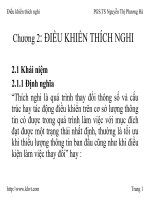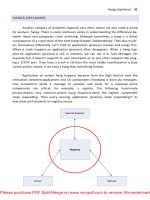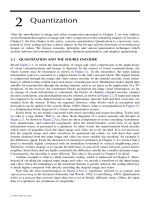Tài liệu Home and Garden Winter P2 doc
Bạn đang xem bản rút gọn của tài liệu. Xem và tải ngay bản đầy đủ của tài liệu tại đây (3 MB, 20 trang )
home&garden 31
coating that reflects up to 70 percent of
heat energy while allowing in visible light,
generally giving it an R-factor of around
4. Some higher-end windows also contain
other insulators such as heat-mirror film
that more than double their insulating
properties to R-9 or higher. Better-quality
windows are beneficial in sunny Colorado,
where you want to block hot summer
sunlight but let in warm winter sunshine.
Triple-paned windows insulate your home
and reduce street noise better than dou-
ble-paned windows, but they can cost
about 50 percent more. Do your math to
make sure the extra expense is justified.
Gas Fillers.
The spaces between
double- and triple-paned windows can
be filled with regular air or inert gases,
such as argon and krypton. Inert gases
are odorless, colorless and nontoxic, plus
they reduce heat transfer. Argon, for
example, has about 33 percent less ther-
mal conductivity than air.
Visible Transmittance Number.
The visible transmittance (VT) number on
your window’s label indicates how much
light the glass lets through. VT values can
range from 0 to 1, but most VT values
fall between 0.3 and 0.8. The higher the
number, the cleaner the glass.
Air Leakage.
Different styles of win-
dows have different rates of air leakage.
Hinged windows generally offer the lowest
leakage rates, but look for an air leakage
rate of less than 0.3, which is the standard
in most areas.
Energy Star
®
Standards.
The U.S.
Department of Energy has proposed
stricter Energy Star
®
standards that
are expected to be phased in starting
in late 2009, and fully implemented by
2013. Among other things, the new rules
will incorporate more specific regional
guidelines for windows, dividing the
country into six territories instead of
four, and placing Colorado in three zones
rather than two. If you want the most
energy-efficient windows available for
our area, some manufacturers, including
New Windows for America in Northglenn
and Accent Windows in Westminster, sell
products that already meet or exceed the
new standards.
Shopping for replacement windows
can be confusing. But armed with a
little knowledge and patience, you can
improve your home’s comfort at the same
time you cut energy costs and help pro-
tect the environment.
Boulder, Colorado
303-993-2645
bluevalleyenergy.com
Use the natural warmth of the earth to heat and cool your home.
• Geothermal systems can dramatically reduce energy use
• Save 40% to 70% on your heating & cooling bills
• The ideal comfort system for new construction and retrofits
Planet Earth
The best heating and cooling system for your home.
Call to learn more about new federal tax rebates for geothermal!
32
home&garden
Glorious
greenhouses
By Debra Melani
Winter is as welcome to gardeners as aphids
are to roses: No more red-ripe juicy toma-
toes, sweet-smelling flowers or warm hours
in the garden. Just snow, wind and cold.
But some green thumbs are easing their
winter blues by taking up greenhouse gar-
dening. “I just like the cozy feeling and the
greenery in wintertime,” says Sue Main,
who has a 6-by-8-foot greenhouse where
she overwinters geraniums, petunias and
fuchsias, and her husband grows tomatoes
and peppers.
Nationwide, greenhouse sales have
increased, especially following the 9/11
food-shortage scare, says Main, a consul-
tant for Charley’s Green house & Garden
in Washington state. More people also
want to grow their own food to avoid
pesticides, E. coli contamination and
other threats. Interest in orchid-growing
has also fueled sales, but it’s the cold-
state gardeners who make up the bulk
of the nearly 1 million U.S. gardeners a
32
home&garden
PHOTOS: TOP BY TT; CENTER AND BOTTOM COURTESY CHARLEY’S GREENHOUSE & GARDEN, CHARLEYSGREENHOUSE.COM
A greenhouse requires research, time and
money, but the payoff is the gift of greenery
and a peaceful, restorative space year-round.
home&garden 33
34
home&garden
GREENHOUSE GRAB BAG
SOLARGRO DOVER
Advantages: Attaches to home, convenient to
use regardless of weather, nearby plumbing and
electrical connections, energy efficient
Disadvantages: Requires careful planning
to fit home, shade-cloth attachment can be
difficult to use
Glazing: Glass and twin- or five-wall
polycarbonate
Size, Price: Wide variety with some
customization available; under $3,000 to
$8,000-plus
SOLARGRO CAPE COD
Advantages: Attractive designs, headroom
for tall plants and hanging baskets,
sheds snow
Disadvantages: Could exceed height
restrictions, more area to heat than some
models
Glazing: Glass and twin- or five-wall
polycarbonate
Size, Price: Wide variety and can be
customized; $5,000 to $20,000-plus
Here are a few greenhouse models from Charley’s Greenhouse & Garden. Check charleysgreenhouse.com for more options.
SOLARGRO PHOENIX
Advantages: Designed for cold, dark
climates, deflects wind, sheds snow, most
energy-efficient model
Disadvantages: Can’t be customized,
except for door and door drop
Glazing: Combination of five-wall
polycarbonate and white insulated panels
Size, Price: 10-by-12 feet, 10-by-16 feet,
10-by-20 feet; $7,950 $9,490, $10,950,
respectively
— Debra Melani
PHOTOS COURTESY CHARLEY’S GREENHOUSE & GARDEN, CHARLEYSGREENHOUSE.COM
home&garden 35
year who have bought greenhouses for
the past five years, says the National
Gardening Association.
A greenhouse is usually a costly invest-
ment that involves more than picking the
prettiest one on a website and hitting
the “order now” button. The selection
depends on your space and budget, and
on what and how much you want to
grow. Many novices opt for greenhouse
kits, which can range from window-box
greenhouses to cozy 4-by-6-footers to
industrial 20-by-50-foot models. Some
suppliers will also customize a green-
house to fit any space.
“Sometimes with kits, you get what you
pay for,” cautions Shane Smith, director of
the Cheyenne Botanic Gardens and author
of Greenhouse Gardener’s Companion.
Buyers will have to invest time and energy
to construct the greenhouse, and the
foundation, electricity and plumbing aren’t
included and often require contractors to
install. These additional expenses can add
up quickly, along with costs for essential
accessories like humidity and misting sys-
tems, benches, and grow lights.
So kit buyers shouldn’t assume a bet-
ter price is a better deal, Smith says,
“because you’re probably getting a lower-
quality product.”
You’ll also have to choose a style for
your greenhouse, which ranges from tradi-
tional (gabled roofs, A-frames and gothic
arches) to offbeat (domes and prisms).
Picking the “glazing”—a greenhouse’s
wall and roof material—involves fore-
thought, too. For Colorado, Main suggests
twin-wall polycarbonate glazing, or five-
wall, if you can afford it. “Unless looks
are especially important,” she says. “Then
you would want glass because you can see
through it a lot better.”
Glass also lasts longer—“unless it
meets up with a rock,” Smith says. But
polycarbonate is more energy efficient—
something to consider if you don’t want
to grow tomatoes that cost more than
store-bought varieties because of heating
bills. Twin-wall polycarbonate costs about
the same as glass, but five-wall bumps
up the price considerably. However, the
increase could quickly be recouped in
energy savings.
For those on a budget, Smith suggests
Solexx greenhouse kits (solexx.com).
The company’s polyethylene blend might
not last quite as long, but offers similar or
better energy efficiency at a lower cost.
Why were we chosen to insulate the Governor’s Mansion?
Because of the results of the Extreme Energy Makeover Home in Boulder.
Bestway Insulation’s experts know how important it is to keep
homes of all sizes well insulated. That includes your home.
Our commitment to reducing your energy bills and keeping
your family comfortable is just one reason why Bestway has
recorded the highest energy savings from insulation for two
years in a row at the Extreme Energy Makeover Homes in
Boulder and Centennial.
In addition, Bestway Insulation is a qualified contractor for the
Insulate Colorado Rebate program, offered by the Governor’s
Energy Office. The program provides a rebate to homeowners
(20% up to $300) who insulate and air-seal their attics and
exterior walls to the recommended R-Values presented in the
2006 International Energy Conservation Code.
We take our work very seriously because we believe all Ameri-
cans have a moral obligation to insulate and seal their homes so
that we don’t waste money or energy that heats up our earth.
SPECIALIZING IN SUPER-INSULATING HOUSES
BESTWAY INSULATION SERVICE
sWWWBESTWAYINSULATIONCOM
36
home&garden
Solexx kits don’t require the permanent
investment of laying a foundation, either.
For newcomers to greenhouse garden-
ing, tent-like cold frame kits, which cost
as little as $300, may be a good way to
go, Smith says. Although not useful year-
round, they do allow you to grow seedlings
very early in the season and keep greenery
growing through late autumn.
Single or Attached?
Perhaps the biggest decision is whether
to buy a freestanding or house-attached
model, which has some advantages,
Smith says. “I’ve always contended that
the closer you are to your greenhouse
physically, the better you’re going to take
care of it. And if you attach it to your
home, that’s about as close as it gets. You
might be more apt to sip your morning
coffee out there and think, ‘I need to
fertilize my orchids.’”
A well-insulated attached greenhouse
on the south side can also decrease home
heating bills, he says. At the same time, the
house buffers the greenhouse from north-
erly winds. Heat, electricity and plumb-
ing are probably more accessible with
an attached greenhouse, which is impor-
tant if you want to garden year-round.
“Otherwise, you shut it down for the three
coldest months or grow only incredibly
tolerant plants,” Smith says. There are also
propane-heater options for greenhouses.
On the flip side, freestanding green-
houses set up anywhere, and come in
larger sizes.
Green Go-Ahead
Before buying a greenhouse, make sure
the doors and frame (typically alumi-
num or wood) are sturdy, and that it
comes with a warranty. Also, be sure the
company provides technical assistance, a
thorough and easy-to-follow manual, and
an instruction video.
Snow and wind load are also impor-
tant factors to consider, especially in our
area. Snow easily slides off steep roofs,
and curved eaves are often not available
in energy-saving polycarbonate models.
Building codes and neighborhood cov-
enants may also govern choices.
Main recommends at least a 75-mph
wind load and 35-pounds-per-square-foot
snow load for greenhouses in Colorado.
“Check with the local codes,” she says,
and see if upgrades are available for the
models you’re interested in.
Despite the expense, time and research
necessary to greenhouse-garden, Smith
predicts it will continue to grow in popu-
larity. “People are getting more into gar-
dening,” he says, “and they really enjoy
picking their own flowers and vegetables.
It’s also just a great cure for winter.”
Insulate with Reflectix (a foil-faced,
bubble-wrap-like material) on the
east, west and north walls, and north
roof portion. Insulate the foundation’s
outside perimeter with a 1-to-2-inch-
thick vertically placed Styrofoam board
that extends down for at least a foot.
Weatherstrip vents and doors,
and caulk cracks
. To determine where
leaks are, close up the greenhouse,
light an incense stick and hold it
against the walls and joints. If the
smoke moves, seal that spot.
Line the north wall with metal
or black drums filled with water. The
drums absorb heat during the day and
release it at night.
Invest in a night curtain, which
you can roll across the inside of
the greenhouse at night. Just like a
blanket, it’s useful in extremely cold
and windy areas.
—Source: Shane Smith,
greenhousegarden.com
“GREEN”HOUSE TIPS
Glass greenhouses
(left) showcase plants
because you can see
through the walls. But
they don’t insulate as
well as polycarbonate
greenhouses (above),
a better choice for
Colorado’s climate and
your energy bills.
PHOTOS COURTESY CHARLEY’S GREENHOUSE & GARDEN, CHARLEYSGREENHOUSE.COM
home&garden 37
38
home&garden
By Debra Melani
Who doesn’t love a spa day? The primping.
The preening. The relaxation. But some-
times it’s hard to find the time. Or maybe
you can’t shell out the bucks. So why not
join the millions of in-home spa goers?
We asked a few experts how to pamper
in private without spending a wad of cash.
Their first suggestion is to get your pri-
orities straight. Instead of thinking about
Spalicious!
Creating an inexpensive in-home spa
is salve for the soul.
what’s for dinner, your kid’s soccer game,
your parent’s health, or anything else,
remember that a spa day is for you. It’s
your time to relax, slow down, breathe
deeply and put yourself first.
Next, stock your home spa with items
that appeal to the five senses: taste, touch,
smell, sight and sound.
To accomplish that, you’ll need a few
essentials on hand: a thick, plush robe
and cushy slippers; a washcloth, a back
brush, and a loofah or other scrubber;
a pitcher of chilled spring water with
lime or lemon and a fancy drinking glass;
a teapot for steeping green or white
tea; your favorite CDs; cleansers, toners
and moisturizers; coarse sea salt, body
scrubs and pumice; fluffy hotel-style cot-
ton towels; luxurious hair-care products;
a bath tray, a pillow and a cooling-gel
eye mask; an aromatherapy diffuser and
natural essential oils; self-massage tools;
PHOTO BY BRIAN CHASE









